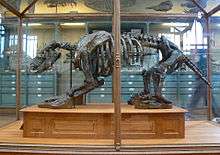Scelidotheriidae
Scelidotheriidae is a family of extinct ground sloths within the order Pilosa, suborder Folivora and superfamily Mylodontoidea, related to the other extinct mylodontoid family, Mylodontidae, as well as to the living two-toed sloth family Choloepodidae. The only other extant family of the suborder Folivora is the distantly related Bradypodidae. Erected as the family Scelidotheriidae by Ameghino in 1889, the taxon was demoted to a subfamily by Gaudin in 1995.[1][2] However, recent collagen sequence data indicates the group is less closely related to Mylodon and Lestodon than Choloepus is, and thus it has been elevated back to full family status by Presslee et al. (2019).[3]
| Scelidotheriidae | |
|---|---|
 | |
| Scelidotherium leptocephalum in Paris | |
| Scientific classification | |
| Kingdom: | Animalia |
| Phylum: | Chordata |
| Class: | Mammalia |
| Order: | Pilosa |
| Suborder: | Folivora |
| Family: | †Scelidotheriidae Ameghino 1889 |
| Genera | |
|
See text | |
Taxonomy
Together with Mylodontidae, the enigmatic Pseudoprepotherium, and two-toed sloths, the scelidotheriids form the superfamily Mylodontoidea. Chubutherium is an ancestral and very plesiomorphic member of this family and does not belong to the main group of closely related genera.
Family †Scelidotheriidae Ameghino 1889
- Genus †Analcitherium
- Genus †Catonyx
- Genus †Chubutherium (basal)
- Genus †Elassotherium
- Genus †Nematherium
- Genus †Neonematherium
- Genus †Proscelidodon
- Genus †Scelidodon
- Genus †Scelidotheriops
- Genus †Scelidotherium
- Genus †Sybillotherium
- Genus †Valgipes
Phylogeny
The following sloth family phylogenetic tree is based on collagen and mitochondrial DNA sequence data (see Fig. 4 of Presslee et al., 2019).[3]
| Folivora |
| |||||||||||||||||||||||||||||||||||||||||||||||||||||||||||||||||||||||||||||
References
- PaleoBiology Database: Scelidotheriinae, basic info
- Gaudin, T. J. (1995-09-14). "The Ear Region of Edentates and the Phylogeny of the Tardigrada (Mammalia, Xenarthra)". Journal of Vertebrate Paleontology. 15 (3): 672–705. doi:10.1080/02724634.1995.10011255. JSTOR 4523658.
- Presslee, S.; Slater, G. J.; Pujos, F.; Forasiepi, A. M.; Fischer, R.; Molloy, K.; Mackie, M.; Olsen, J. V.; Kramarz, A.; Taglioretti, M.; Scaglia, F.; Lezcano, M.; Lanata, J. L.; Southon, J.; Feranec, R.; Bloch, J.; Hajduk, A.; Martin, F. M.; Gismondi, R. S.; Reguero, M.; de Muizon, C.; Greenwood, A.; Chait, B. T.; Penkman, K.; Collins, M.; MacPhee, R.D.E. (2019). "Palaeoproteomics resolves sloth relationships". Nature Ecology & Evolution. 3 (7): 1121–1130. doi:10.1038/s41559-019-0909-z. PMID 31171860.
Further reading
- Cuvier, G. (1796): Notice sur le squellette d'une très grande espèce de quadrupède inconnue jusqu'à présent, trouvé au Paraquay, et déposé au cabinet d'histoire naturelle de Madrid. Magasin encyopédique, ou Journal des Sciences, des Lettres et des Arts (1): 303-310; (2): 227-228.
- Iuliis, G.; Cartelle, C. (December 1999). "A new giant megatheriine ground sloth (Mammalia: Xenarthra: Megatheriidae) from the late Blancan to early Irvingtonian of Florida". Zoological Journal of the Linnean Society. 1 27 (4): 495–515. doi:10.1006/zjls.1998.0190.
- Harrington, C.R. (1993): Yukon Beringia Interpretive Center - Jefferson's Ground Sloth. Retrieved 2008-JAN-24.
- Hogan, C.M. (2008): Cueva del Milodon, Megalithic Portal. Retrieved 2008-APR-13
- Kurtén, B.; Anderson, E. (1980). Pleistocene Mammals of North America. Columbia University Press. ISBN 978-0-231-03733-4. OCLC 776120509.
- McKenna, M. C.; Bell, S. K. (1997). Classification of Mammals: Above the Species Level. Columbia University Press. ISBN 978-0-231-52853-5. OCLC 182575570.
- Nowak, R.M. (1999): Walker's Mammals of the World (Vol. 2). Johns Hopkins University Press, London.
- White, J. (1993). "Indicators of locomotor habits in xenarthrans: Evidence for locomotor heterogeneity among fossil sloths". Journal of Vertebrate Paleontology. 13 (2): 230–242. doi:10.1080/02724634.1993.10011502.
- White, J.L.; MacPhee, R.D.E. (2001). "The sloths of the West Indies: a systematic and phylogenetic review". In Woods, C.A.; Sergile, F.E. (eds.). Biogeography of the West Indies: Patterns and Perspectives. Boca Raton, London, New York, and Washington, D.C.: CRC Press. pp. 201–235. doi:10.1201/9781420039481-14. ISBN 978-0-8493-2001-9.
- Woodward, A. S. (January 1900). "On some Remains of Grypotherium (Neomylodori) listai and associated Mammals from a Cavern near Consuelo Cove, Last Hope Inlet, Patagonia". Proceedings of the Zoological Society of London. 69 (1): 64–78. doi:10.1111/j.1096-3642.1890.tb01704.x.
External links
| Wikimedia Commons has media related to Ground Sloth. |